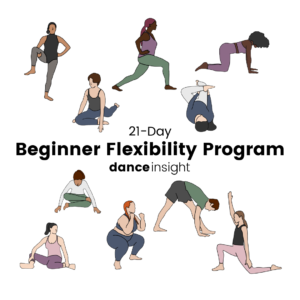
Recently, I had the opportunity to participate in a hybrid virtual dance intensive. Some students were physically present in the classroom and others learned from home over Zoom. As this is such new territory in the world of dance instruction, I wanted to share my experience as one of the virtual learners.
I hope you find this insight helpful, whether you’re a teacher looking to improve your students’ online experience, or someone in the future studying how online dance classes got started! (Because let’s face it, virtual dance learning is not going to just disappear once the pandemic is over.)
For context: I am a professional dancer, and this hybrid online dance intensive was designed “for advanced dancers ages 16+.” The intensive was contemporary-based, featuring three 1.5hr classes a day: improv, technique, and repertoire.
Here are the topics I cover below:
- Learning combos in a new way
- Asking questions and receiving feedback
- A different mental experience
- Home is not the dance studio
- How does (or should) pricing differ for online dance students?
Drop a comment at the end and let us know if you’ve had similar or different experiences!
Learning combos in a new way
Back when we were all dancing at home, classes were modified to work for small spaces. Everyone, the teacher included, barely had enough room to dance full-out in their kitchen or living room, so classes were planned accordingly.
That was roughly March to May 2020. Over the summer, as quarantine restrictions lifted, many dance studios transitioned to socially-distanced, in-person classes, whether outdoors or in the studio. And now, because of social distancing guidelines, students actually have more space to dance than ever before. If you’ve ever tried to dance full-out in a small, crowded classroom, you’ll understand what a blessing this actually is!
It makes complete sense that dance classes aren’t modified for the home studio anymore. When you’re an online participant in an in-person class, you have to modify the combos yourself. This goes for spacing as well as surfaces. One of the hybrid classes I took called for a lot of floor spins, which were nearly impossible in my wall-to-wall carpet apartment.
Having to modify every combo was a bit frustrating, even as an advanced dancer who had the experience necessary to do so. I can only imagine how much more frustrating it would be for a dancer with less experience, who might not know how to modify combos on their own.
Here’s another observation I made in my online dance eperience: if you don’t know the combo, and the teacher’s not demonstrating, you’re kinda screwed.
In-person students can glance at each other if they forget the next step. Online students can’t.*(Unless you have amazing eyesight and can watch the little Zoom boxes.) There were several times during my intensive when I had to just stop dancing in the middle of a combo because I forgot what came next. Again, frustrating and a little embarassing, but I also wouldn’t expect a teacher to demonstrate all the time, especially in an advanced class.
*The camera for my intensive was set up so that only the teacher was visible on screen, and there were no mirrors. I’m sure setups differ and this may not be a problem everywhere!
Asking questions and receiving feedback
How did questions work for online students? For the intensive I attended, online students submitted questions via Zoom’s chat. This worked fine – aside from some difficulty describing movements with words – as long as the teacher remembered to check on us. Often our questions wouldn’t get noticed until we had moved on to the next combo, or even the next class of the day.
Did online students get personal corrections? Not really. The teachers would watch the screen for a minute and occasionally say, “Good guys, that looks great,” or even, “Good [student’s name],” but we never got personal corrections.
There could have been many reasons for this. Sometimes video cals are so laggy and it’s so hard to get good lighting that you really can’t see well enough to give corrections. It’s also perfectly understandable that a dance teacher’s attention can’t be on everyone at once. That’s hard enough to do under normal circumstances, much less when you have both a room of a students and a screen to manage.
Even so, not getting personal feedback made me feel like I was getting less out of the experience. There were times when it felt more like observing on the sidelines than actually being a student in class. I did pay less than the in-person students, which I think was appropriate. More on that later!
It’s a different mental experience
So far, I’ve said mostly negative things about my online dance intensive experience, but there were positive aspects as well! One of the biggest being that overall, I felt much less pressure than I would in a normal dance class. I think there were several reasons for this:
- No one but the teacher can see you. Okay, technically the other Zoom participants can see you, but they’d have to stop dancing and stare at the screen. So you don’t have to worry about being judged by your peers or comparing yourself to anyone.
- Your environment is less formal. There’s less pressure to look a certain way, have a certain posture, etc.
- It’s easier to take little micro-breaks. Stepping off camera to drink water and check your phone is easy and no one questions it. (This can be a good thing and a bad thing, more on that later!)
For dancers who tend to get anxious *raises hand* or feel constricted by constant comparison to others *raises other hand*, online classes could be a welcome relief. It could also be more stressful, though, for reasons I mentioned above (i.e. getting lost if you forget the combo). Everyone’s going to have different experiences and opinions!
Let’s talk about loneliness while we’re at it. Doing anything online that you used to do in person is lonely. I’m sure you’ve felt it if you’ve ever taken an online dance class. To me, the loneliness was even more pronounced when I knew that other people got to be there in person.
In my case, though, I reminded myself that I had no choice but to participate online. The intensive was in Canada, and even if I had the means to pay for travel and lodging, US citizens aren’t really allowed to travel anywhere right now because of COVID-19. As much as I would have loved to spend a week dancing in Vancouver, online was the only way I could have possibly participated.
Home is not the dance studio
Unless you have a large empty space and an even larger budget, it’s nearly impossible to recreate a dance studio environment at home. And that’s okay. Your home is not supposed to be a dance studio. We’re all just doing the best we can in this crazy time. (Read my tips for How to Set Up a Dance Practice Space at Home)
Aside from the obvious disadvantages like limited space and unlimited obstacles, here are some issues with (and benefits to) dancing at home that I didn’t think of until I experienced them:
- Dancing on carpet sucks. There’s no two ways about it. Barefoot, the fibers get caught on your toenails and stuck to your sweaty feet, and wearing socks creates so much friction that your whole body gets uncomfortably hot. Any sliding on the floor is out of the question.
- Distractions are everywhere. From unfinished chores, to pets, to wondering what’s playing on the TV in the next room. I can only imagine what online classes must be like for parents with kids.
- Even without distractions, it’s harder to focus. Your phone is right there and no one will call you out for checking it. And that’s assuming you already fought off the urge to stay in bed or watch TV and even made it to dance class in the first place.
- However, it is much easier to take notes! At a studio, your notebook or dance journal would probably be in your bag in the lobby, or at the very least, off to the side of the room. At home, you can have your notebook handy and write down corrections or advice as soon as the teacher gives it! No more trying to remember everything at the end of class.
How does (or should) pricing differ for online dance students?
I paid a little over 50% of what the in-person students paid for my dance intensive. It came to about $10 per 1.5hr class when converted to US currency. That’s incredibly reasonable, especially for an intensive. (More on standard dance class pricing in my post How Much Do Dance Classes Cost? Note that it was written before the pandemic.)
I would have been willing to pay much more than I did, but I do think it’s only fair that online students pay less than in-person students.
In-person dance students are paying for:
- Room to dance full out
- Proper flooring
- Personal feedback from the instructor
- The ability to ask questions in real time and get clear answers
- The ability to hear the music without lag or distortion
- Freedom from distractions
- The beautiful experience of physically sharing the space and moving together as a group
All of those things make in-person dance classes worth more than online dance classes.
There’s a huge monetary benefit to online dance classes, though, whether you pay the same or less than those dancing in person. O p p o r t u n i t i e s.
I got to take a week of classes from prominent Vancouver-based dancers that I have admired for years, all from my apartment on the East Coast of the United States. I can still barely grasp it. Between travel, hotel, food, and tuition, I could have spent well over $2000 going to this intensive in person, and I got to participate online for less than 10% of that. Wow.
The whole world of dance is open to you right now through online classes, and that’s not something to take for granted. Yes, you won’t get as much out of it as you would in person, but can you get enough out of it to make it 100% worth the effort? Absolutely.







